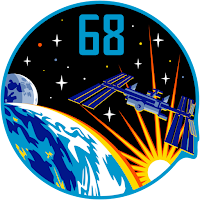ISS - Expedition 68 Mission patch.
Feb 16, 2023
A multitude of advanced microgravity research benefitting humans and robotics took precedence aboard the International Space Station on Thursday.
Two Expedition 68 astronauts investigated how living in space affects the way a crew member reaches for and grasps objects. NASA Flight Engineer Josh Cassada has been working in the Columbus laboratory module all week exploring how spaceflight impacts the central nervous system. He first studied how astronauts regulate their grip force. Then on Thursday, Cassada explored how an astronaut’s eye-hand coordination is impacted by visual and audible signals in weightlessness.
Image above: The Himalayan peaks are pictured in this oblique photograph from the International Space Station as it orbited 260 miles above central China on Feb. 8, 2023. Image Credit: NASA.
Flight Engineer Koichi Wakata of the Japan Aerospace Exploration Agency (JAXA) joined Cassada inside the Columbus module for the space adaptation study. Both astronauts took turns seated in a specialized chair, wearing a virtual reality headset and responded to virtual stimuli on a computer. Observations may inform scientists how the human brain adjusts to microgravity and help treat balance and orientation conditions humans may experience on Earth.
Blood pressure and breathing in weightlessness are also key research objectives as scientists learn to counteract the risks of living in space and prepare astronauts for the differing gravity environments of the Moon, Mars, and beyond. NASA Flight Engineer Nicole Mann, with assistance from NASA Flight Engineer Frank Rubio, worked on a study combining both research areas on Thursday while wearing a headband and garment packed with sensors and pedaling on exercise bike. The Cardiobreath investigation involves measuring an astronaut’s exercise output and may help improve medical support for crews in space and humans on Earth.
Image above: Astronaut Josh Cassada plays with a sphere of water flying in microgravity, dyed with green food coloring and bubbling due to an antacid that was placed inside. Image Credit: NASA.
Mann and Cassada later participated in vein scans using the Ultrasound 2 device imaging each other’s neck, shoulder, and leg veins. Rubio turned on an Astrobee robotic helper and installed an acoustic monitor on the device and collected station sound level readings during the afternoon.
Commander Sergey Prokopyev joined Flight Engineer Dmitri Petelin and reviewed procedures for the upcoming automated undocking of the ISS Progress 82 cargo craft. Flight Engineer Anna Kikina started her day working on electronics maintenance then performed a fitness evaluation on the Zvezda service module’s treadmill while attached to sensors.
Related links:
Expedition 68: https://www.nasa.gov/mission_pages/station/expeditions/expedition68/index.html
Columbus laboratory module: https://www.nasa.gov/mission_pages/station/structure/elements/europe-columbus-laboratory
Grip force: https://www.nasa.gov/mission_pages/station/research/experiments/explorer/Investigation.html?#id=1188
Eye-hand coordination: https://www.nasa.gov/mission_pages/station/research/experiments/explorer/Investigation.html?#id=2038
Cardiobreath: https://www.nasa.gov/mission_pages/station/research/experiments/explorer/Investigation.html?#id=8597
Ultrasound 2: https://www.nasa.gov/mission_pages/station/research/experiments/explorer/Facility.html?#id=736
Astrobee: https://www.nasa.gov/mission_pages/station/research/experiments/explorer/Facility.html?#id=1891
Station sound level readings: https://www.nasa.gov/mission_pages/station/research/experiments/explorer/Investigation.html?#id=7860
Zvezda service module: https://www.nasa.gov/mission_pages/station/structure/elements/zvezda-service-module.html
Space Station Research and Technology: https://www.nasa.gov/mission_pages/station/research/overview.html
International Space Station (ISS): https://www.nasa.gov/mission_pages/station/main/index.html
Images (mentioned), Text, Credits: NASA/Mark Garcia.
Greetings, Orbiter.ch



